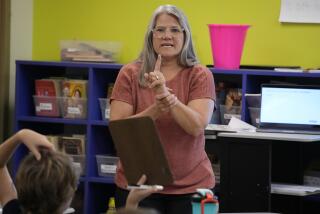Teachers Group Recommends Math Lessons in Preschool
- Share via
CHICAGO — The professional organization of math teachers recommended Wednesday that lessons begin in preschool and that all students, not only those bound for college, take four years of math in high school.
The new standards released by the National Council of Teachers of Mathematics break down goals for students by grade levels and categories, including geometry, algebra, measurement, data analysis and problem solving. Other recommendations include allowing the use of calculators at all age levels and requiring students to be familiar with algebra and geometry by the eighth grade.
Standards 2000 is the first revision of a 1989 document that brought both change and controversy to the nation’s classrooms. That early plan recommended making math more meaningful by changing the focus from drills, rules and rote learning to “real-world” problem solving. Critics berated it for fostering “fuzzy math” that they said undermined high academic standards.
The organization’s leaders said in interviews that their intent in the 1989 document was widely misinterpreted. The new prescription, they say, represents a concerted attempt to clarify their position.
“We’ve always been for students being able to compute with paper and pencil and being able to recite their basic facts, but we want them to be able to do more than that,” said Lee V. Stiff, the organization’s incoming president and a math education professor at North Carolina State University.
In 1989, the math council was the first of the professional education groups to issue standards in reaction to a woeful description of mediocrity contained in the “Nation at Risk” report on the public schools issued in 1983 by the Reagan administration.
Other groups followed with standards in English, science and history. All, to one degree or another, became mired in controversy, with conservative critics contending that they had more to do with political correctness than academic rigor.
The math standards had a profound impact on textbooks, teacher training and teaching methods used around the world, an impact that leaders of the math organization said far exceeded their expectations.
They also sparked a long-running debate over mathematics that has raged in classrooms, legislatures and even courtrooms, where parents have sued to restore traditional teaching methods to their schools.
Critics have charged that the early standards emphasized trendy teaching methods at the expense of correct answers and that math-like activities using objects such as M&Ms; had squeezed aside numbers.
Although acknowledging the criticism, Joan Ferrini-Mundy, a former council president who headed a 26-member team that wrote Standards 2000, said the council has not altered its basic views of what adds up to good math education.
In particular, she said, the council remains committed to letting teachers and students develop alternatives to traditional arithmetic procedures. The council also approves of using calculators to help understand numbers.
But she said the writing team listened to critics and tried to provide greater guidance to teachers where warranted. Nonetheless, Ferrini-Mundy conceded that the new standards will not placate critics.
Richard Askey, a math professor at the University of Wisconsin at Madison and a vocal critic of the standards, disputed the statement that the 1989 recommendations had been misunderstood. He said the council was very clear about how to teach many procedures and was simply wrong.
A new element of Standards 2000 is the inclusion of preschool recommendations. Children are able from a very early age to understand concepts such as less and more and to use blocks or their fingers to count, said Alfinio Flores, a professor of math education at Arizona State University.
According to the standards, teachers can help even the youngest children explore numbers and patterns and solve problems using calculators. California, while not prohibiting calculator use, discourages it before the sixth grade.
Standards 2000 also says that all high school students need four years of math, regardless of whether they want to attend college. According to a report this year from the Council of Chief State School Officers, about 39% of high school graduates now take that much math.
Alan Schoenfeld, a UC Berkeley mathematician who headed the high school writing team, said the point is that all students need to be able to think mathematically, not just for success in college but on the job and in life as well.
“Before, it was symbolic math for the elite and dump the others aside,” he said. “Now it’s a core understanding for everybody--and those who want and need more--give it to them.”
Council leaders said the vision contained in Standards 2000 will not be achievable unless teachers at all levels are given a chance to learn more mathematics themselves. Elementary and middle school teachers in particular, according to the council, often have not mastered the math that they are expected to teach their students.
More to Read
Sign up for Essential California
The most important California stories and recommendations in your inbox every morning.
You may occasionally receive promotional content from the Los Angeles Times.













